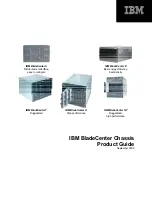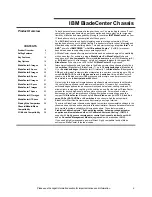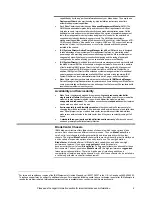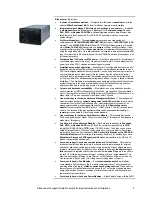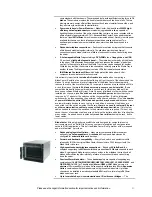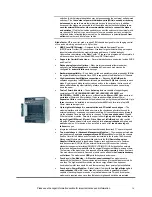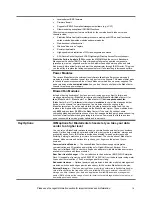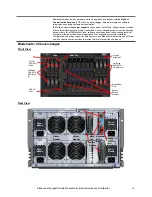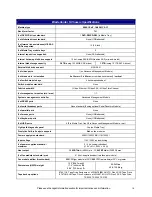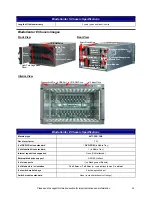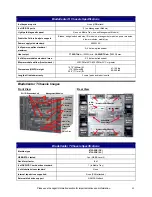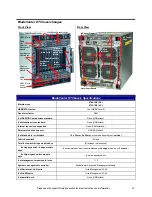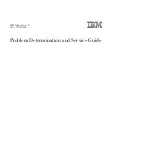
switches. (And the integrated switches may be less expensive than external, self-powered
switches.) Plus,
the number of power distribution units (PDUs) needed per rack may
be lessened
, because there are fewer discrete devices to have to plug in. In addition,
because all the blades are connected to all the switches inside the chassis,
there is no
need for external Ethernet or other communication cables to connect the blades
and switches
. (Only the few cables needed to connect the switches to the external world
are required.) This not only can save the cost of numerous cables per rack, but also the
clutter and bother of routing that many cables. An added bonus is potentially
much freer
airflow
behind the rack, due to fewer cables.
BladeCenter HT
is a carrier grade, rugged
12U
chassis designed for challenging central
office and networking environments. It provides:
•
NEBS Level 3/ETSI-tested
— Designed for the Network Equipment Provider
(NEP)/Service Provider (SP) environment. Also ideal for government/military, aerospace,
industrial automation/robotics, medical imaging and finance.
Certified testing by
Underwriters Laboratories of the BladeCenter HT chassis is in progress; when complete, it
will be covered under a UL-certified NEBS Level 3/ETSI test report.
•
Support for Carrier-Grade Linux
— Several distributions are supported, include SUSE
and Red Hat.
•
Reduced single points of failure
— Many major components (either standard or
optionally) are
hot-swappable
and/or
redundant
. Servers and modules can be
configured for
automatic failover
to backups.
•
Backward compatibility
— Every blade, switch and passthru module released by IBM for
the original BladeCenter chassis since 2002, is supported in the BladeCenter HT chassis.
•
High-speed redundant Midplane connections
— Based on
4X InfiniBand
, the
midplane supports up to
40Gb
bandwidth and provides
four 10Gb
data channels to each
blade. By giving each blade
two physical connections
to the midplane that connects all
blades and modules together internally, a failure of one connector alone cannot bring
down the server.
•
Twelve 30mm blade slots
— These
hot-swap
slots are capable of supporting any
combination of
12
HC10/HS20/HS21/HS21 XM
,
LS20/LS21
,
JS20/JS21
, and
QS21/QS22
or
10
JS22
blade servers, or
6
double-wide (
60mm
)
LS41
blade servers, or
a
mixture
of 30mm and 60mm blades. It also supports multiple optional 30mm
Expansion Units
in combination with the blade servers, using the same blade slots. Up to
three
chassis can be installed in an industry-standard
42U
rack, for a total of up to
36
30mm blade servers per rack.
•
Up to eight module bays
for
communication and I/O switches
or bridges
— The
modules interface with all of the blade servers in the chassis and alleviate the need for
external switches or expensive, cumbersome cabling. All connections are done internally
via the midplane.
Two
module slots are reserved for
hot-swap/redundant
Gigabit
Ethernet switch modules.
Two
slots support either
high-speed bridge modules
or
legacy Gigabit Ethernet
,
Myrinet
,
Fibre
Channel
,
InfiniBand
and other switch
modules.
Four
additional slots are dedicated for
hot-swap/redundant
high-speed
switch
modules. All modules, when installed in pairs, offer
load
balancing
and
failover
support.
•
Integrated
switch and bridge modules mean that no additional rack “U” space is required.
•
Two module bays
for
Advanced Management Modules
— The management modules
provide advanced
systems management and KVM
capabilities for not only the chassis
itself, but for all of the blades and other modules installed in the chassis. The Advanced
Management Module provides capabilities similar to the IBM
Remote Supervisor
Adapter II
SlimLine
used in stand-alone System x rack and tower servers. Features
include concurrent KVM (cKVM), an external Serial over LAN connection, industry-
standard management interfaces (SMASH/CLP/CIM/HPI), USB virtualization, network
failover and backward compatibility with the original Management Module, among others.
The features of the module can be accessed either
locally
or
remotely
across a network.
One module comes standard. A second module can be added for
hot-swap/redundancy
and
failover
. The module uses
USB
ports for keyboard and mouse.
•
Four bays
for
Fan Modules
—
All four
hot-swap/redundant
fan modules come
standard with the chassis. These modules replace the need for each blade to contain its
own fans. The high-availability modules are more energy efficient than dozens or
hundreds of smaller fans would be, and there are many fewer points of potential failure.
•
Four bays
for
Power Modules
— BladeCenter HT ships with
two
high-efficiency hot-
swap/redundant DC
or
AC
(model-specific)
power modules (upgradeable to
four
),
capable of handling the power needs of up to
six
blade servers. Two
additional
power
modules are required when
more
than
6
blades
or
high-speed switches are installed.
Please see the Legal Information section for important notices and information.
14.

